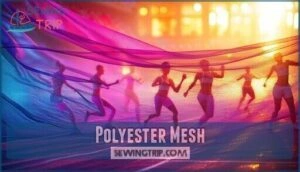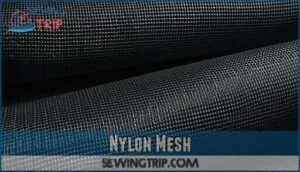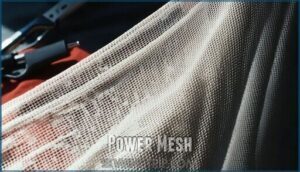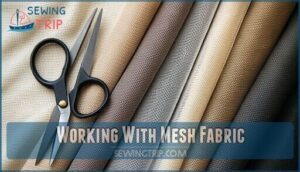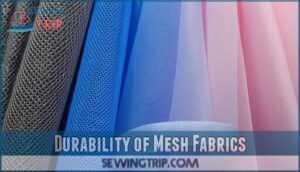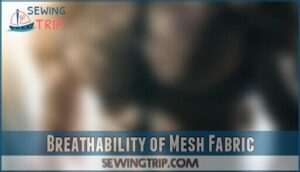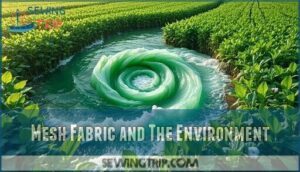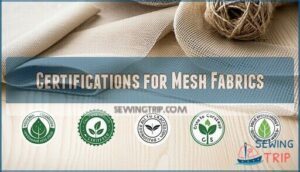This site is supported by our readers. We may earn a commission, at no cost to you, if you purchase through links.
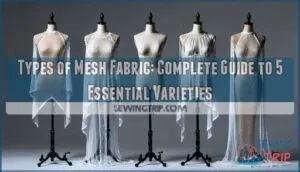
Polyester mesh offers durability and versatility for sportswear and bags.
Nylon mesh provides exceptional strength for athletic gear and outdoor equipment.
Power mesh delivers firm support with stretch, making it perfect for activewear and undergarments.
Tulle brings delicate elegance to wedding veils and formal wear.
Mesh netting features an open weave structure ideal for laundry bags and storage.
Each type has unique properties that match specific project needs.
Whether you’re creating breathable summer clothing or sturdy outdoor gear, understanding these distinctions helps you pick the right material.
The secret lies in matching mesh characteristics to your intended application, which is key to selecting the perfect mesh for your needs, and ultimately leads to creating breathable and durable products.
Table Of Contents
- Key Takeaways
- What is Mesh Fabric?
- History of Mesh Fabric
- Types of Mesh Fabric
- Properties of Mesh Fabric
- Uses of Mesh Fabric
- Working With Mesh Fabric
- Durability of Mesh Fabrics
- Breathability of Mesh Fabric
- Mesh Fabric and The Environment
- Certifications for Mesh Fabrics
- Frequently Asked Questions (FAQs)
- Conclusion
Key Takeaways
- You’ll find five main mesh fabric types that serve different purposes – polyester mesh for versatile sportswear, nylon mesh for durability, power mesh for stretch support, tulle for delicate formal wear, and mesh netting for heavy-duty applications.
- You can maximize breathability and performance by matching mesh characteristics to your specific project needs – lighter weights offer better ventilation while heavier versions provide more durability and coverage.
- You’ll need special techniques when working with mesh fabric, including sharp rotary cutters to prevent snagging, ballpoint needles for sewing, and stabilizers to maintain the fabric’s delicate structure during construction.
- You should consider environmental impact when choosing mesh fabrics – while synthetic options like polyester and nylon offer superior performance, they don’t biodegrade, so look for recycled or biodegradable alternatives when sustainability matters.
What is Mesh Fabric?
Mesh fabric is a textile with an open weave structure that creates evenly spaced holes throughout the material.
Breathable by design, mesh fabric transforms ordinary textiles into ventilated wonders that keep you cool and comfortable.
This unique fabric construction allows air to flow freely, making it breathable and lightweight. The mesh definition encompasses various fiber compositions, including polyester, nylon, cotton, and spandex blends.
Open weaves distinguish mesh from solid fabrics, giving it distinctive properties like transparency and ventilation.
Fabric versatility makes mesh suitable for everything from athletic wear to decorative applications.
Different types of mesh fabric serve specific purposes, from supportive shapewear to delicate bridal veils, showcasing the diverse fabric types available today.
History of Mesh Fabric
You might wonder how this breathable wonder came to be.
Ancient Mesh techniques appeared centuries ago when craftspeople wove loose patterns for fishing nets and grain storage. Industrial Origins began in the 1880s when British textile mills developed systematic mesh fabric manufacturing processes.
One key factor in mesh creation is weave structure’s impact on breathability.
Here’s how mesh fabric history and evolution unfolded:
- 1888: Aertex fabric launched as the first commercial mesh for clothing
- 1930s: Military Applications expanded mesh use in equipment and uniforms
- 1950s: Synthetic fibers revolutionized mesh durability and performance
- 1970s: Fashion Evolution brought mesh into mainstream sportswear
- 2000s: Modern Innovations introduced technical mesh varieties
Types of Mesh Fabric
You’ll find five main types of mesh fabric, each designed for specific purposes and performance needs.
These varieties include polyester mesh for athletic wear, nylon mesh for durability, power mesh for stretch applications, delicate tulle for formal garments, and heavy-duty mesh netting for industrial uses.
Polyester Mesh
Polyester mesh stands out among mesh fabric types as the workhorse of synthetic fibers.
You’ll find this petroleum-based material in countless activewear applications thanks to its moisture-wicking polyester properties.
Unlike cotton, it dries fast and won’t shrink. Various weave variations create different breathability levels.
Dyeing polyester requires heat, but the results last. Cost analysis shows it’s budget-friendly for most projects.
Nylon Mesh
You’ll find nylon mesh stands tough against wear and tear, making it perfect for outdoor gear and industrial applications.
This synthetic fiber brings serious durability factors to the table – it won’t quit when you need it most.
Many spandex blends enhance flexibility while maintaining strength. Military uses prove its reliability, from MOLLE vests to equipment covers that handle harsh conditions.
Power Mesh
Power mesh, a stretchy and breathable fabric, is perfect for shapewear applications and compression garments.
Crafted from spandex mesh, it blends strength and elasticity to shape and support without restricting movement.
- Offers great stretch recovery for lasting use.
- Delivers various support levels.
- Provides lightweight compression benefits.
- Guarantees flexibility through blending options.
- Gently sculpts curves with ease.
Power mesh is often used for activewear, and to prevent puckering, consider using a walking foot attachment.
Tulle
Tulle creates magic in your wardrobe with its delicate hexagonal weave.
This sheer mesh transforms ordinary garments into stunning pieces through its lightweight construction and ethereal appearance.
You’ll find tulle variations ranging from stiff polyester to flowing silk, each offering unique properties for your creative projects.
| Property | Description |
|---|---|
| Tulle stiffness | Ranges from paper-like rigidity to soft drape |
| Tulle applications | Wedding veils, ballet tutus, formal gowns |
| Tulle embellishments | Sequins, beads, glitter, embroidery patterns |
| Tulle alternatives | Chiffon, organza, fine mesh netting |
| Dancewear uses | Tutus, costume overlays, decorative accents |
Mesh Netting
Moving beyond delicate tulle, mesh netting brings serious durability to your projects.
This open mesh construction features evenly spaced holes in grid patterns, creating sturdy nets perfect for sports facilities and outdoor gear.
Made from polyester, nylon, or cotton materials, hexagonal mesh offers superior netting construction, with its practical netting applications including warehouse storage, balcony protection, and athletic equipment where reliable netting alternatives matter most, providing superior netting construction.
Properties of Mesh Fabric
Understanding mesh fabric characteristics starts with recognizing how its open-grid structure creates unique performance benefits.
The mesh fabric properties you’ll encounter depend on several key factors that determine how the material behaves in different situations.
Here are the five essential properties that define mesh fabrics:
- Breathability – Air flows freely through the open weave, preventing heat buildup and moisture retention during physical activities.
- Mesh Weight – Lighter fabrics offer better ventilation while heavier versions provide more durability and coverage.
- Weave Tightness – Tighter weaves reduce sheerness but may limit airflow, while looser weaves maximize breathability but increase snagging risk.
- Water Resistance – Most synthetic mesh fabrics naturally repel moisture, with some featuring special coatings for enhanced protection.
- Tensile Strength – The fabric’s ability to resist tearing varies substantially based on fiber type and construction method.
Additional finish options like antimicrobial treatments and moisture-wicking capabilities enhance performance.
Considering the fabric’s GSM impacts its drape and durability.
Durability ranges from delicate tulle to industrial-strength netting, making proper selection vital for your specific application.
Uses of Mesh Fabric
Across countless industries, mesh fabric proves its worth through diverse applications.
In fashion, you’ll find mesh creating breathable activewear applications that keep athletes cool during intense workouts.
Designers incorporate mesh into clothing applications ranging from trendy streetwear to elegant evening gowns where transparency adds visual interest.
Industrial mesh serves heavy-duty purposes in filtration systems, safety barriers, and construction materials.
These robust fabrics withstand harsh conditions while maintaining their structural integrity.
Medical uses include surgical implants and wound dressings where the open weave promotes healing and drainage.
For decorative purposes, mesh transforms spaces through window treatments, room dividers, and artistic installations.
Outdoor gear benefits from mesh’s lightweight durability in backpack panels, tent ventilation, and camping equipment.
Fashion accessories like bags, shoes, and jewelry incorporate mesh for both function and style.
Whether you’re designing high-performance sportswear or creating eye-catching home décor, mesh fabric adapts to meet your specific needs.
Working With Mesh Fabric
You’ll find that mesh fabric requires specific techniques to prevent runs and maintain its structure during cutting and sewing.
Sharp scissors and stabilizers become essential tools when you’re working with these open-weave materials to achieve professional results.
Cutting Mesh
Sharp cutting techniques make all the difference when working with mesh fabric. A rotary cutter beats scissors every time because it won’t snag those delicate open weaves.
The rolling blade glides smoothly through the grid pattern, preventing fraying that scissors often cause. For blade selection, choose a fresh, sharp rotary blade to guarantee clean cuts.
Many rely on specialized cutter options for superior results. When fabric handling gets tricky with slippery mesh, try stabilizing mesh by placing it between tissue paper layers.
This sandwich method keeps everything in place while you cut. Pattern matching becomes easier when you can see through the mesh’s transparent areas clearly, allowing for more precise pattern matching and handling of the fabric.
Sewing Mesh
Once you’ve cut your mesh fabric cleanly, sewing mesh requires specific techniques to handle its delicate structure.
Success depends on proper preparation and the right approach.
Here are five essential mesh fabric sewing techniques that’ll transform your project:
- Needle Selection: Use ballpoint or stretch needles to glide through mesh without creating snags or runs
- Stabilizing Mesh: Place tissue paper underneath during stitching to prevent fabric from being pulled into the feed dogs
- Seam Finishes: Apply zigzag or overlock stitches to prevent fraying and maintain stretch properties
- Pattern Adjustments: Reduce seam allowances slightly since mesh doesn’t fray like woven fabrics
- Pressing Techniques: Use low heat with a press cloth to avoid melting synthetic fibers
Using the right mesh sewing needles is vital for successful projects.
These mesh sewing tips guarantee professional results every time.
Durability of Mesh Fabrics
Mesh durability depends on several key factors that determine how long your fabric will last.
Fiber quality plays the biggest role – polyester and nylon mesh offer superior strength compared to delicate tulle.
Weave tightness affects tear resistance, while abrasion resistance varies by material type.
| Mesh Type | Mesh Lifespan | Wear Resistance |
|---|---|---|
| Polyester | 5-10 years | High |
| Nylon | 3-8 years | Very High |
| Tulle | 1-3 years | Low |
Power mesh provides excellent strength for activewear, while mesh netting handles outdoor conditions best.
Proper care and matching mesh fabric to your intended use maximizes durability.
Breathability of Mesh Fabric
Breathability makes mesh fabric your go-to choice for staying cool and dry.
The open weave structure creates natural mesh ventilation, allowing air to flow freely through tiny gaps between fibers.
Weave density determines airflow levels – looser patterns offer maximum breathability while tighter ones provide moderate ventilation.
Fiber choice affects moisture-wicking capabilities, with synthetic materials excelling at pulling sweat away from skin.
Your activity level should guide selection, as high-intensity workouts demand superior airflow.
This skin comfort feature prevents overheating during physical activities, ensuring you stay cool and dry with mesh fabric.
Mesh Fabric and The Environment
While mesh fabrics offer excellent performance, their environmental impact deserves your attention.
Most synthetic mesh materials like polyester and nylon don’t biodegrade, potentially polluting ecosystems for thousands of years.
These petroleum-based fabrics can release microplastics into waterways, harming marine life.
However, you can make more sustainable choices.
Recycled mesh fabrics reduce waste by repurposing existing materials, cutting down on virgin resource consumption.
Some manufacturers now offer biodegradable options made from organic cotton or other natural fibers.
Sustainable dyes minimize chemical runoff during production.
Look for brands practicing ethical production methods that prioritize waste reduction.
Recycling programs help extend fabric lifecycles, supporting sustainability goals.
While synthetic mesh remains dominant due to its durability and performance, the industry is gradually shifting toward eco-friendly alternatives.
Your purchasing decisions can drive demand for environmentally responsible mesh fabric options.
Certifications for Mesh Fabrics
When shopping for mesh fabrics, you’ll want to look for certifications that guarantee Standard Compliance and chemical safety.
Smart shoppers demand certified mesh fabrics that protect both people and planet through rigorous testing standards.
These Quality Assurance markers protect both you and your customers from harmful substances while supporting sustainability goals.
Key certifications to seek include:
- OEKO-TEX Standard 100 – Tests for over 1,000 harmful chemicals and guarantees Safety Regulations compliance
- GOTS Certification – Covers the entire supply chain with strict environmental impact standards
- Cradle to Cradle Certified – Focuses on Performance Testing across five sustainability categories
- Blue Angel Ecolabel – German government-backed Eco-Certifications for environmental protection
- CertiPUR – Specialized testing for polyurethane foam components in mesh products
These certifications transform fabric selection from guesswork into informed decision-making, guaranteeing your mesh choices meet rigorous health and environmental standards.
Frequently Asked Questions (FAQs)
How many types of mesh fabric are there?
Textile manufacturers create over 15 distinct mesh fabric varieties.
You’ll find polyester, nylon, cotton, spandex, power mesh, tulle, fishnet, tricot, spacer mesh, safety mesh, medical mesh, insect mesh, hex mesh, vinyl mesh, and lace mesh options available.
What is another name for mesh fabric?
You’ll often hear mesh fabric called "netting" or "net fabric" in everyday conversation.
Some folks also refer to it as "screen fabric" or simply "open-weave fabric", depending on the specific application you’re using it for.
How many types of mesh are there?
Ever wondered about the variety in mesh?
You’ll find dozens of different mesh types available.
The most common include polyester, nylon, power, tulle, tricot, spacer, and specialty meshes like safety and medical varieties.
What is netting fabric called?
Netting fabric goes by several names depending on its use.
You’ll find it called mesh, net, tulle, or fishnet.
Industrial versions are often called mesh netting, while delicate types are simply tulle or lace mesh.
How do you clean and care for different types of mesh fabric?
Despite concerns about delicate fibers, you’ll find most mesh fabrics surprisingly easy to maintain.
Machine wash synthetic mesh in cold water, air dry to prevent heat damage.
Hand wash delicate tulle gently.
How to prevent mesh fabric from snagging?
Handle mesh fabric gently to prevent snagging.
Wash in garment bags, avoid rough surfaces, and store carefully.
Choose tighter weaves over open ones.
Use delicate cycle settings and keep sharp objects away from your mesh items.
Can mesh fabric be dyed at home?
About 70% of synthetic mesh fabrics accept dye successfully when proper techniques are used.
You can dye most polyester and nylon mesh at home using fabric dye, though results vary by mesh density and fiber composition.
What causes mesh fabric to lose stretch?
Your mesh fabric loses stretch when you overstretch it repeatedly.
It also loses stretch when you expose it to high heat during washing or drying.
When the elastane fibers break down over time from normal wear and chemical exposure, your mesh fabric loses stretch.
How to remove stains from mesh fabric?
Like a detective solving a mystery, you’ll tackle mesh stains by pre-treating with gentle detergent, using cold water, and avoiding harsh scrubbing.
Rinse thoroughly, then air-dry to preserve the fabric’s delicate structure.
Is mesh fabric suitable for winter clothing?
You can wear lightweight mesh in winter layered under other garments for breathability, but standard mesh isn’t warm enough alone.
Power mesh works better for base layers since it traps some heat while wicking moisture.
Conclusion
While synthetic fabrics dominate today’s market, natural fibers once ruled textile production entirely.
Understanding the five main types of mesh fabric empowers you to make informed decisions for your projects.
Polyester mesh delivers versatility, nylon mesh provides strength, power mesh offers support, tulle adds elegance, and mesh netting serves practical storage needs.
Each variety brings unique properties that match specific applications, and you’ll achieve better results when you select the right mesh type for your intended use and requirements.


